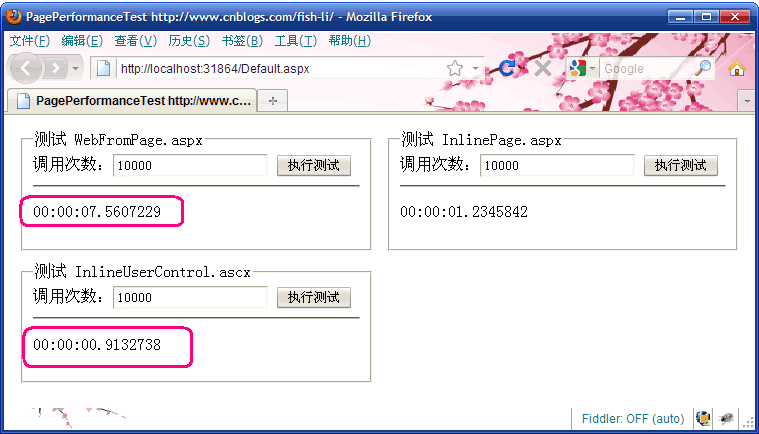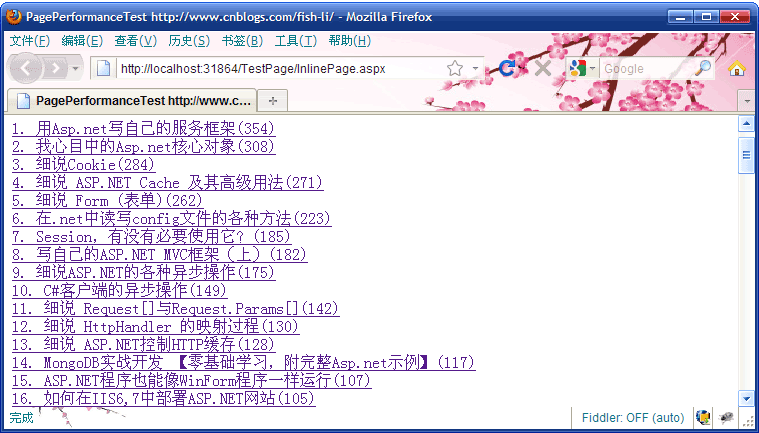ASP.NET页面优化性能提升方法记录
2018-06-17 19:50:38来源:未知 阅读 ()

今天与大家分享:一种优化页面执行速度的方法。
采用这个方法,可以使用页面的执行速度获得【8倍】的提升效果。
为了让您对优化的效果有个直观的了解,我准备了下面的测试结果截图:

测试环境:
1. Windows Server 2003 SP2
2. Viaual Studio 2008,使用自带的WebDev.WebServer.EXE运行网站程序。
3. (ThinkPad SL510):Core2 T6670 2.2GHz, 4G内存
二个红框中的数字反映了优化前后的执行时间。
数字表明:优化前后,执行时间有了8倍多的差别。
本文的测试结果也仅仅只是一个参考数字,这个结果也只是根据我所设计的测试页面得出的。
优化的过程中,如果不使用服务器控件,那么给GC减少的压力其实也是无法测试到的。
在测试过程中,我还发现测试结果并不是很稳定,因此截图具有一定的偶然性。
测试页面或许在某些方面存在一些片面性,因此,结果仅供参考。
测试背景
看过了优化结果,再来介绍一下:这个测试到底是在测试什么东西?
现在有很多做ASP.NET的开发人员,应该都是从ASP.NET的WebForm编程模型开始学习的。大家都很喜欢用服务器控件,不管输出什么,都会使用服务器控件。有时候为了让页面呈现干净的HTML代码,有些人会选择使用Repeater,Literal这类简单的服务器控件。或许有些人认为:我已不使用GridView这样强大复杂的控件,页面执行速度已经很快了。
真是这样吗?
今天测试的起点就从使用简单的服务器开始,我会分二次对它做一系列的性能优化。
最终就是上图中的3个结果,它们反映了二次优化的改进过程。
在继续介绍之前,有一点我想有必要说明一下:
优化的过程涉及到ASP.NET服务器控件的使用,测试结果也仅仅只是一个参考数字。
如果您认为您的开发工作非常依赖于服务器控件的使用,
那么测试结果对您来说其实是无意义的,请不要在意这个结果。
测试方法
在这次优化过程中,我并没有设计很复杂的测试页面,而是一个很简单的测试页面,页面显示效果如下:

这个页面其实就是显示了一堆超链接,它们来自于我的博客侧边栏的【推荐排行榜】,总共有20条记录,我让页面重复5次输出,也就是生成了100个超链接。
测试的数据是这样获取的:
我复制了我的博客侧边栏的【推荐排行榜】的那段HTML代码,保存到一个文件中:

然后,网站在初始化时,从这段HTML代码提取链接地址以及显示文字,保存到一个BlogInfo的列表中,代码如下:
public class BlogInfo
{
public string Title;
public string Href;
}
public static class XmlDb
{
public static List<BlogInfo> Blogs { get; private set; }
public static void LoadBlogs()
{
string filePath = Path.Combine(HttpRuntime.AppDomainAppPath, @"App_Data\RecommendList.html");
XElement html = XElement.Parse(System.IO.File.ReadAllText(filePath));
Blogs =
(from a in html.Elements("li").Elements("a")
select new BlogInfo { Title = a.Value, Href = a.Attribute("href").Value }).ToList();
}
}
测试时,就把XmlDb.Blogs的内容显示在网页中。
我想这个测试还是比较接近于现实开发的。
这里又有一个问题:我如何测试页面的执行速度?
虽然说创建HttpWebRequest访问页面是个很简单的方法,但我并不打算这样做。
因为从HttpWebRequest发起调用到获取结果,这其中除了有页面的执行时间,还混杂较多的额外调用开销。最终,我选择了在一次HTTP请求中,循环调用Server.Execute来执行页面,并统计时间的方式。其实如何选择测试方法,对于二个测试对象还说,都是公平的。只是说:尽量减少一些额外的调用开销,会让测试结果的差异更大,也更明显。
说明:为了测试代码写起来简单,我使用了MyMVC框架。
测试用例1:WebFromPage.aspx
前面介绍了测试背景以及测试方法。现在就来介绍第1个测试用例,它采用了WebForm编程模型中最经典的写法。
页面代码: 
<%@ Page Language="C#" CodeFile="WebFromPage.aspx.cs" Inherits="TestPage_WebFromPage" %>
<html xmlns="http://www.w3.org/1999/xhtml">
<head>
<title>PagePerformanceTest http://www.cnblogs.com/fish-li/</title>
</head>
<body>
<p>This is WebFromPage.aspx</p>
<asp:Repeater ID="repeater1" runat="server" onitemdatabound="repeater1_ItemDataBound">
<ItemTemplate>
<asp:HyperLink ID="link1" runat="server"></asp:HyperLink><br />
</ItemTemplate>
<FooterTemplate><hr /></FooterTemplate>
</asp:Repeater>
<asp:Repeater ID="repeater2" runat="server" onitemdatabound="repeater1_ItemDataBound">
<ItemTemplate>
<asp:HyperLink ID="link1" runat="server"></asp:HyperLink><br />
</ItemTemplate>
<FooterTemplate><hr /></FooterTemplate>
</asp:Repeater>
<asp:Repeater ID="repeater3" runat="server" onitemdatabound="repeater1_ItemDataBound">
<ItemTemplate>
<asp:HyperLink ID="link1" runat="server"></asp:HyperLink><br />
</ItemTemplate>
<FooterTemplate><hr /></FooterTemplate>
</asp:Repeater>
<asp:Repeater ID="repeater4" runat="server" onitemdatabound="repeater1_ItemDataBound">
<ItemTemplate>
<asp:HyperLink ID="link1" runat="server"></asp:HyperLink><br />
</ItemTemplate>
<FooterTemplate><hr /></FooterTemplate>
</asp:Repeater>
<asp:Repeater ID="repeater5" runat="server" onitemdatabound="repeater1_ItemDataBound">
<ItemTemplate>
<asp:HyperLink ID="link1" runat="server"></asp:HyperLink><br />
</ItemTemplate>
<FooterTemplate><hr /></FooterTemplate>
</asp:Repeater>
</body>
</html>
页面的CodeFile代码: 
public partial class TestPage_WebFromPage : System.Web.UI.Page
{
protected override void OnLoad(EventArgs e)
{
base.OnLoad(e);
repeater1.DataSource = XmlDb.Blogs;
repeater1.DataBind();
repeater2.DataSource = XmlDb.Blogs;
repeater2.DataBind();
repeater3.DataSource = XmlDb.Blogs;
repeater3.DataBind();
repeater4.DataSource = XmlDb.Blogs;
repeater4.DataBind();
repeater5.DataSource = XmlDb.Blogs;
repeater5.DataBind();
}
protected void repeater1_ItemDataBound(object sender, RepeaterItemEventArgs e)
{
if( e.Item.ItemType == ListItemType.Item ) {
BlogInfo blog = e.Item.DataItem as BlogInfo;
HyperLink link1 = e.Item.FindControl("link1") as HyperLink;
link1.NavigateUrl = blog.Href;
link1.Text = blog.Title;
}
}
}
测试代码: 
[Action]
public object Test1(string callTimes)
{
int count = 0;
int.TryParse(callTimes, out count);
if( count <= 0 )
return count;
HttpContext context = HttpContext.Current;
// 先执行一次,排除编译时间
string html = MyMVC.PageExecutor.Render(context, "/TestPage/WebFromPage.aspx", null);
Stopwatch watch = Stopwatch.StartNew();
for( int i = 0; i < count; i++ )
html = MyMVC.PageExecutor.Render(context, "/TestPage/WebFromPage.aspx", null);
watch.Stop();
return watch.Elapsed.ToString();
}
当我测试执行10000次时,耗时:00:00:07.5607229
测试用例2:InlinePage.aspx
与测试用例1不同,测试用例2则完全不使用服务器控件。
页面代码: 
<%@ Page Language="C#" %>
<html xmlns="http://www.w3.org/1999/xhtml">
<head>
<title>PagePerformanceTest http://www.cnblogs.com/fish-li/</title>
</head>
<body>
<p>This is InlinePage.aspx</p>
<% foreach( BlogInfo b in XmlDb.Blogs ) { %>
<a href="<%= b.Href %>" target="_blank"><%= b.Title %></a><br />
<% } %>
<hr />
<% foreach( BlogInfo b in XmlDb.Blogs ) { %>
<a href="<%= b.Href %>" target="_blank"><%= b.Title %></a><br />
<% } %>
<hr />
<% foreach( BlogInfo b in XmlDb.Blogs ) { %>
<a href="<%= b.Href %>" target="_blank"><%= b.Title %></a><br />
<% } %>
<hr />
<% foreach( BlogInfo b in XmlDb.Blogs ) { %>
<a href="<%= b.Href %>" target="_blank"><%= b.Title %></a><br />
<% } %>
<hr />
<% foreach( BlogInfo b in XmlDb.Blogs ) { %>
<a href="<%= b.Href %>" target="_blank"><%= b.Title %></a><br />
<% } %>
<hr />
</body>
</html>
测试代码: 
[Action]
public object Test2(string callTimes)
{
int count = 0;
int.TryParse(callTimes, out count);
if( count <= 0 )
return count;
HttpContext context = HttpContext.Current;
// 先执行一次,排除编译时间
string html = MyMVC.PageExecutor.Render(context, "/TestPage/InlinePage.aspx", null);
Stopwatch watch = Stopwatch.StartNew();
for( int i = 0; i < count; i++ )
html = MyMVC.PageExecutor.Render(context, "/TestPage/InlinePage.aspx", null);
watch.Stop();
return watch.Elapsed.ToString();
}
当我测试执行10000次时,耗时:00:00:01.2345842
分析优化结果1
测试用例1执行相同次数所花费的时间是测试用例2的6倍,为什么会这样呢?
为了回答这个问题,我们首先要知道前面二个页面在执行时,它们是如何运行的。
说到这里,就不得不谈ASP.NET的页面编译方式了。
ASP.NET的页面编译过程是个复杂的操作,其实我们可以不用关心页面是如何编译的,
但要知道:页面编译后是什么样的。
为了能直观地了解页面编译后的样子,我编译了整个网站,并生成到一个DLL文件中,然后使用Reflector.exe来分析这个DLL的源代码。
将网站编译成一个DLL文件有二个方法:
1. 安装WebDeployment插件。
2. 使用我的工具:FishAspnetTool。 
在编译网站之后,我就可以知道网站在运行时如何运行页面了。
测试用例1的页面,最后被编译成这样了: 
namespace ASP
{
using System;
using System.Diagnostics;
using System.Runtime.CompilerServices;
using System.Web;
using System.Web.UI;
using System.Web.UI.WebControls;
[CompilerGlobalScope]
public class testpage_webfrompage_aspx : TestPage_WebFromPage, IHttpHandler
{
private static object __fileDependencies;
private static bool __initialized;
[DebuggerNonUserCode]
public testpage_webfrompage_aspx()
{
base.AppRelativeVirtualPath = "~/TestPage/WebFromPage.aspx";
if (!__initialized)
{
string[] virtualFileDependencies = new string[] { "~/TestPage/WebFromPage.aspx", "~/TestPage/WebFromPage.aspx.cs" };
__fileDependencies = base.GetWrappedFileDependencies(virtualFileDependencies);
__initialized = true;
}
base.Server.ScriptTimeout = 0x1c9c380;
}
[DebuggerNonUserCode]
private void __BuildControl__control10(Control __ctrl)
{
IParserAccessor accessor = __ctrl;
accessor.AddParsedSubObject(new LiteralControl("<hr />"));
}
[DebuggerNonUserCode]
private void __BuildControl__control11(Control __ctrl)
{
IParserAccessor accessor = __ctrl;
accessor.AddParsedSubObject(new LiteralControl("\r\n\t"));
HyperLink link = this.__BuildControl__control12();
accessor.AddParsedSubObject(link);
accessor.AddParsedSubObject(new LiteralControl("<br />\r\n"));
}
[DebuggerNonUserCode]
private HyperLink __BuildControl__control12()
{
HyperLink link = new HyperLink {
TemplateControl = this
};
link.ApplyStyleSheetSkin(this);
link.ID = "link1";
return link;
}
[DebuggerNonUserCode]
private void __BuildControl__control13(Control __ctrl)
{
IParserAccessor accessor = __ctrl;
accessor.AddParsedSubObject(new LiteralControl("<hr />"));
}
[DebuggerNonUserCode]
private void __BuildControl__control14(Control __ctrl)
{
IParserAccessor accessor = __ctrl;
accessor.AddParsedSubObject(new LiteralControl("\r\n\t"));
HyperLink link = this.__BuildControl__control15();
accessor.AddParsedSubObject(link);
accessor.AddParsedSubObject(new LiteralControl("<br />\r\n"));
}
[DebuggerNonUserCode]
private HyperLink __BuildControl__control15()
{
HyperLink link = new HyperLink {
TemplateControl = this
};
link.ApplyStyleSheetSkin(this);
link.ID = "link1";
return link;
}
[DebuggerNonUserCode]
private void __BuildControl__control16(Control __ctrl)
{
IParserAccessor accessor = __ctrl;
accessor.AddParsedSubObject(new LiteralControl("<hr />"));
}
[DebuggerNonUserCode]
private void __BuildControl__control2(Control __ctrl)
{
IParserAccessor accessor = __ctrl;
accessor.AddParsedSubObject(new LiteralControl("\r\n\t"));
HyperLink link = this.__BuildControl__control3();
accessor.AddParsedSubObject(link);
accessor.AddParsedSubObject(new LiteralControl("<br />\r\n"));
}
[DebuggerNonUserCode]
private HyperLink __BuildControl__control3()
{
HyperLink link = new HyperLink {
TemplateControl = this
};
link.ApplyStyleSheetSkin(this);
link.ID = "link1";
return link;
}
[DebuggerNonUserCode]
private void __BuildControl__control4(Control __ctrl)
{
IParserAccessor accessor = __ctrl;
accessor.AddParsedSubObject(new LiteralControl("<hr />"));
}
[DebuggerNonUserCode]
private void __BuildControl__control5(Control __ctrl)
{
IParserAccessor accessor = __ctrl;
accessor.AddParsedSubObject(new LiteralControl("\r\n\t"));
HyperLink link = this.__BuildControl__control6();
accessor.AddParsedSubObject(link);
accessor.AddParsedSubObject(new LiteralControl("<br />\r\n"));
}
[DebuggerNonUserCode]
private HyperLink __BuildControl__control6()
{
HyperLink link = new HyperLink {
TemplateControl = this
};
link.ApplyStyleSheetSkin(this);
link.ID = "link1";
return link;
}
[DebuggerNonUserCode]
private void __BuildControl__control7(Control __ctrl)
{
IParserAccessor accessor = __ctrl;
accessor.AddParsedSubObject(new LiteralControl("<hr />"));
}
[DebuggerNonUserCode]
private void __BuildControl__control8(Control __ctrl)
{
IParserAccessor accessor = __ctrl;
accessor.AddParsedSubObject(new LiteralControl("\r\n\t"));
HyperLink link = this.__BuildControl__control9();
accessor.AddParsedSubObject(link);
accessor.AddParsedSubObject(new LiteralControl("<br />\r\n"));
}
[DebuggerNonUserCode]
private HyperLink __BuildControl__control9()
{
HyperLink link = new HyperLink {
TemplateControl = this
};
link.ApplyStyleSheetSkin(this);
link.ID = "link1";
return link;
}
[DebuggerNonUserCode]
private Repeater __BuildControlrepeater1()
{
Repeater repeater = new Repeater();
base.repeater1 = repeater;
repeater.ItemTemplate = new CompiledTemplateBuilder(new BuildTemplateMethod(this.__BuildControl__control2));
repeater.FooterTemplate = new CompiledTemplateBuilder(new BuildTemplateMethod(this.__BuildControl__control4));
repeater.ID = "repeater1";
repeater.ItemDataBound += new RepeaterItemEventHandler(this.repeater1_ItemDataBound);
return repeater;
}
[DebuggerNonUserCode]
private Repeater __BuildControlrepeater2()
{
Repeater repeater = new Repeater();
base.repeater2 = repeater;
repeater.ItemTemplate = new CompiledTemplateBuilder(new BuildTemplateMethod(this.__BuildControl__control5));
repeater.FooterTemplate = new CompiledTemplateBuilder(new BuildTemplateMethod(this.__BuildControl__control7));
repeater.ID = "repeater2";
repeater.ItemDataBound += new RepeaterItemEventHandler(this.repeater1_ItemDataBound);
return repeater;
}
[DebuggerNonUserCode]
private Repeater __BuildControlrepeater3()
{
Repeater repeater = new Repeater();
base.repeater3 = repeater;
repeater.ItemTemplate = new CompiledTemplateBuilder(new BuildTemplateMethod(this.__BuildControl__control8));
repeater.FooterTemplate = new CompiledTemplateBuilder(new BuildTemplateMethod(this.__BuildControl__control10));
repeater.ID = "repeater3";
repeater.ItemDataBound += new RepeaterItemEventHandler(this.repeater1_ItemDataBound);
return repeater;
}
[DebuggerNonUserCode]
private Repeater __BuildControlrepeater4()
{
Repeater repeater = new Repeater();
base.repeater4 = repeater;
repeater.ItemTemplate = new CompiledTemplateBuilder(new BuildTemplateMethod(this.__BuildControl__control11));
repeater.FooterTemplate = new CompiledTemplateBuilder(new BuildTemplateMethod(this.__BuildControl__control13));
repeater.ID = "repeater4";
repeater.ItemDataBound += new RepeaterItemEventHandler(this.repeater1_ItemDataBound);
return repeater;
}
[DebuggerNonUserCode]
private Repeater __BuildControlrepeater5()
{
Repeater repeater = new Repeater();
base.repeater5 = repeater;
repeater.ItemTemplate = new CompiledTemplateBuilder(new BuildTemplateMethod(this.__BuildControl__control14));
repeater.FooterTemplate = new CompiledTemplateBuilder(new BuildTemplateMethod(this.__BuildControl__control16));
repeater.ID = "repeater5";
repeater.ItemDataBound += new RepeaterItemEventHandler(this.repeater1_ItemDataBound);
return repeater;
}
[DebuggerNonUserCode]
private void __BuildControlTree(testpage_webfrompage_aspx __ctrl)
{
__ctrl.EnableViewState = false;
__ctrl.EnableViewStateMac = false;
this.InitializeCulture();
IParserAccessor accessor = __ctrl;
accessor.AddParsedSubObject(new LiteralControl("\r\n\r\n<html xmlns=\"http://www.w3.org/1999/xhtml\">\r\n<head>\r\n <title>PagePerformanceTest http://www.cnblogs.com/fish-li/</title>\r\n</head>\r\n<body>\r\n\r\n<p>This is WebFromPage.aspx</p>\r\n\r\n"));
Repeater repeater = this.__BuildControlrepeater1();
accessor.AddParsedSubObject(repeater);
accessor.AddParsedSubObject(new LiteralControl("\r\n\r\n"));
Repeater repeater2 = this.__BuildControlrepeater2();
accessor.AddParsedSubObject(repeater2);
accessor.AddParsedSubObject(new LiteralControl("\r\n\r\n"));
Repeater repeater3 = this.__BuildControlrepeater3();
accessor.AddParsedSubObject(repeater3);
accessor.AddParsedSubObject(new LiteralControl("\r\n\r\n"));
Repeater repeater4 = this.__BuildControlrepeater4();
accessor.AddParsedSubObject(repeater4);
accessor.AddParsedSubObject(new LiteralControl("\r\n\r\n"));
Repeater repeater5 = this.__BuildControlrepeater5();
accessor.AddParsedSubObject(repeater5);
accessor.AddParsedSubObject(new LiteralControl("\r\n\r\n\r\n</body>\r\n</html>\r\n"));
}
[DebuggerNonUserCode]
protected override void FrameworkInitialize()
{
base.FrameworkInitialize();
this.__BuildControlTree(this);
base.AddWrappedFileDependencies(__fileDependencies);
base.Request.ValidateInput();
}
[DebuggerNonUserCode]
public override int GetTypeHashCode()
{
return -781896338;
}
[DebuggerNonUserCode]
public override void ProcessRequest(HttpContext context)
{
base.ProcessRequest(context);
}
protected override bool SupportAutoEvents
{
get
{
return false;
}
}
}
}
从这个编译结果我们可以看出:页面上的所有文字最后也被包装到LiteralControl中。
页面中呈现时,就是循环调用每个控件的Render方法来最终生成HTML结果。
测试用例2的页面被编译成这个样了: 
namespace ASP
{
using System;
using System.Diagnostics;
using System.Runtime.CompilerServices;
using System.Web;
using System.Web.Profile;
using System.Web.UI;
[CompilerGlobalScope]
public class testpage_inlinepage_aspx : Page, IHttpHandler
{
private static object __fileDependencies;
private static bool __initialized;
[DebuggerNonUserCode]
public testpage_inlinepage_aspx()
{
base.AppRelativeVirtualPath = "~/TestPage/InlinePage.aspx";
if (!__initialized)
{
string[] virtualFileDependencies = new string[] { "~/TestPage/InlinePage.aspx" };
__fileDependencies = base.GetWrappedFileDependencies(virtualFileDependencies);
__initialized = true;
}
base.Server.ScriptTimeout = 0x1c9c380;
}
[DebuggerNonUserCode]
private void __BuildControlTree(testpage_inlinepage_aspx __ctrl)
{
__ctrl.EnableViewState = false;
__ctrl.EnableViewStateMac = false;
this.InitializeCulture();
__ctrl.SetRenderMethodDelegate(new RenderMethod(this.__Render__control1));
}
private void __Render__control1(HtmlTextWriter __w, Control parameterContainer)
{
__w.Write("\r\n\r\n<html xmlns=\"http://www.w3.org/1999/xhtml\">\r\n<head>\r\n <title>PagePerformanceTest http://www.cnblogs.com/fish-li/</title>\r\n</head>\r\n<body>\r\n\r\n<p>This is InlinePage.aspx</p>\r\n\r\n");
foreach (BlogInfo info in XmlDb.Blogs)
{
__w.Write("\r\n\t<a href=\"");
__w.Write(info.Href);
__w.Write("\" target=\"_blank\">");
__w.Write(info.Title);
__w.Write("</a><br />\r\n");
}
__w.Write("\r\n<hr />\r\n\r\n");
foreach (BlogInfo info2 in XmlDb.Blogs)
{
__w.Write("\r\n\t<a href=\"");
__w.Write(info2.Href);
__w.Write("\" target=\"_blank\">");
__w.Write(info2.Title);
__w.Write("</a><br />\r\n");
}
__w.Write("\r\n<hr />\r\n\r\n");
foreach (BlogInfo info3 in XmlDb.Blogs)
{
__w.Write("\r\n\t<a href=\"");
__w.Write(info3.Href);
__w.Write("\" target=\"_blank\">");
__w.Write(info3.Title);
__w.Write("</a><br />\r\n");
}
__w.Write("\r\n<hr />\r\n\r\n");
foreach (BlogInfo info4 in XmlDb.Blogs)
{
__w.Write("\r\n\t<a href=\"");
__w.Write(info4.Href);
__w.Write("\" target=\"_blank\">");
__w.Write(info4.Title);
__w.Write("</a><br />\r\n");
}
__w.Write("\r\n<hr />\r\n\r\n");
foreach (BlogInfo info5 in XmlDb.Blogs)
{
__w.Write("\r\n\t<a href=\"");
__w.Write(info5.Href);
__w.Write("\" target=\"_blank\">");
__w.Write(info5.Title);
__w.Write("</a><br />\r\n");
}
__w.Write("\r\n<hr />\r\n\r\n</body>\r\n</html>\r\n");
}
[DebuggerNonUserCode]
protected override void FrameworkInitialize()
{
base.FrameworkInitialize();
this.__BuildControlTree(this);
base.AddWrappedFileDependencies(__fileDependencies);
base.Request.ValidateInput();
}
[DebuggerNonUserCode]
public override int GetTypeHashCode()
{
return -1307842476;
}
[DebuggerNonUserCode]
public override void ProcessRequest(HttpContext context)
{
base.ProcessRequest(context);
}
protected global_asax ApplicationInstance
{
get
{
return (global_asax) this.Context.ApplicationInstance;
}
}
protected DefaultProfile Profile
{
get
{
return (DefaultProfile) this.Context.Profile;
}
}
protected override bool SupportAutoEvents
{
get
{
return false;
}
}
}
}
请注意下面这段关键的代码:它们实在太重要了。
private void __BuildControlTree(testpage_inlinepage_aspx __ctrl)
{
// .......
__ctrl.SetRenderMethodDelegate(new RenderMethod(this.__Render__control1));
}
private void __Render__control1(HtmlTextWriter __w, Control parameterContainer)
{
testpage_inlinepage_aspx与testpage_webfrompage_aspx的编译结果完全不同。
最大的差别在testpage_inlinepage_aspx有个方法:__Render__control1
在这个方法中,页面的内容将直接被写入到HtmlTextWriter对象中。
还有一点我要告诉您:每个Control的输出最后还是要将自己的显示代码写入到HtmlTextWriter对象中。
因此,从这里就可以明显地看出testpage_inlinepage_aspx的执行速度要快很多,
因为:
1. 它没有服务器控件。
2. 不再需要递归循环每个控件,每个控件的生命周期的调用开销也节省了。
3. 不用再创建那些服务器控件对象,GC的压力会小很多。
4. 输出方式更高效。
通过前面的分析,您现在明白了为什么二个页面的执行速度相差6倍了原因了吧。
好像还有一点没有解释:__Render__control1如何被调用?
我们都知道:以ASPX页面为代表的WebForm编程模型在执行时有一个特点:递归循环每个控件。
页面是在Render阶段输出的,页面的HTML代码也是在那个阶段输出到HtmlTextWriter对象中的。
可是,testpage_inlinepage_aspx没有任何控件,那又该如何递归呢?
的确,很多书籍以及技术资料都是说:在Render阶段会递归循环每个控件并调用控件的Render方法。
其实这种说法是不准确的。Control的Render方法在运行时,会调用下面这个方法: 
internal void RenderChildrenInternal(HtmlTextWriter writer, ICollection children)
{
if ((this.RareFields != null) && (this.RareFields.RenderMethod != null))
{
writer.BeginRender();
this.RareFields.RenderMethod(writer, this);
writer.EndRender();
}
else if (children != null)
{
foreach (Control control in children)
{
control.RenderControl(writer);
}
}
}
这段代码中,有个重要的if...else...判断,简单说来,就是说要不要调用前面所说的__Render__control1方法。
从代码可以看出,如果是进入了if语句块,则不用递归循环每个控件并调用控件的Render方法。
那么如何能进入if语句块呢?
答案是:调用Control.SetRenderMethodDelegate方法。
testpage_inlinepage_aspx的编译生成代码中就有这个调用。
对于这个方法,MSDN的解释很含糊:
此 API 支持 .NET Framework 基础结构,不适合在代码中直接使用。
分配事件处理程序委托,以将服务器控件及其内容呈现到父控件中。
测试用例3:InlineUserControl.ascx
在测试用例3中,我将页面中用于输出的代码移到一个用户控件中。
用户控件的代码此处省略,与测试用例2的代码基本上一致。编译后的结果也基本差不多。
测试代码: 
[Action]
public object Test3(string callTimes)
{
int count = 0;
int.TryParse(callTimes, out count);
if( count <= 0 )
return count;
// 先执行一次,排除编译时间
string html = MyMVC.UcExecutor.Render("/UserControl/InlineUserControl.ascx", null);
Stopwatch watch = Stopwatch.StartNew();
for( int i = 0; i < count; i++ )
html = MyMVC.UcExecutor.Render("/UserControl/InlineUserControl.ascx", null);
watch.Stop();
return watch.Elapsed.ToString();
}
当我测试执行10000次时,耗时:00:00:00.9132738
又快了一点。
说明:为了这次的性能优化,MyMVC框架也做了一点调整。如果您以前下载过这个框架,请重新下载。
分析优化结果2
经过前面的分析,我们知道:不创建服务器控件对象以及不调用它们的生命周期,可以让页面的执行速度快很多。
有没有再想像一下:页面也有生命周期啊,而且生命周期的步骤更长,省略它,会不会更快呢?
不过,Render方法并不是个public方法,我们还不能直接调用,但可以调用RenderControl方法来实现这一过程。
由于跳过页面的生命周期,任何服务器控件都不能使用了,包括母板页。所以我选择将前面测试用的那段代码移到用户控件中,然后将用户控件加载到Page中来测试。
测试用例3与测试用例2相比,在测试过程中,由于跳过了页面的生命周期,因此速度也就更快了。
注意:事实上,动态加载用户控件也会有一定的调用开销。这种方法也仅供参考,可以根据实际情况来选择。
嗯,基本上,就是这个简单的原因吧。
由于这种方法没有任何的控件生命周期,因此速度是最快的。
经过这一系列的优化,页面的执行时间最终由 00:00:07.5607229 减少到 00:00:00.9132738
再次申明:测试结果也仅仅只是一个参考数字。
事实上,使用服务器控件产生的对象涉及到GC的回收以及内存占用的影响也是不可忽视的。
标签:
版权申明:本站文章部分自网络,如有侵权,请联系:west999com@outlook.com
特别注意:本站所有转载文章言论不代表本站观点,本站所提供的摄影照片,插画,设计作品,如需使用,请与原作者联系,版权归原作者所有
- SQL如何查询语句优化 2020-02-26
- Laravel 已登陆用户再次查看登陆页面的自动跳转设置方法 2019-09-30
- MySQL性能优化的20条经验 2019-09-23
- PHP高并发优化处理——redis层面详细步骤 2019-09-17
- 项目上线后,谈一下感触比较深的一点:查询优化 2019-09-08
IDC资讯: 主机资讯 注册资讯 托管资讯 vps资讯 网站建设
网站运营: 建站经验 策划盈利 搜索优化 网站推广 免费资源
网络编程: Asp.Net编程 Asp编程 Php编程 Xml编程 Access Mssql Mysql 其它
服务器技术: Web服务器 Ftp服务器 Mail服务器 Dns服务器 安全防护
软件技巧: 其它软件 Word Excel Powerpoint Ghost Vista QQ空间 QQ FlashGet 迅雷
网页制作: FrontPages Dreamweaver Javascript css photoshop fireworks Flash
